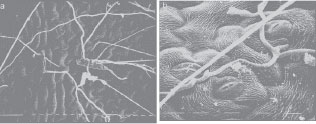Plant Tissue Culture demonstration by Using Somaclonal Variation to Select for Disease Resistance
The carrot cultivator Fancy when used in laboratory generated a series of 197 regenerant progeny lines. These
 |
| Figure 3 Scanning electron micrographs of surface of carrot leaf 3 days after inoculation with A. dauci. (LHS) germination from multiseptate conidiospore (RHS) penetration of hyphae through the epidermal surface rather than through stomata. Scale bar = 10 micrometers. |
One symptom of the disease is loss of chlorophyl and total soluble polyphenol compounds. These reduce to a low level, 6 days after inoculation of excised leaves with A. dauci spores, when compared with uninoculated leaves. Regenerant progeny with high chlorophyl levels maintained higher chlorophyl levels after challenge with A. dauci. After self-pollinating selected high- and low-chlorophyl regenerant plants, this characteristic was inherited by their progeny, suggesting that the capacity to resist this infection is inherited.




